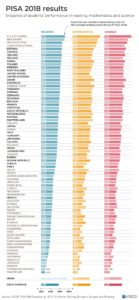On the first day of the school year as a graduate teacher I encountered a slap in the face. My day started brimming with confidence but that all changed when one boy walked through the door. His name was Jacob and I quickly discovered that he could not read a single word. A Year 4 student, with four years of full time schooling under his belt and he had somehow ‘slipped through the cracks’ of education. How could this be?
The next shock came when I delved into my mental toolkit of how to help him, and realized I had no idea where to begin. How was it possible that a newly graduated primary school teacher had not been taught how to teach a child the foundations of reading?
Reading research and Australia’s gradual reading decline
Fast-forward one year and it was the year 2000. Some 21 years ago now, some very significant research came out from the National Reading Panel in the US, around what instructional skills made the greatest impact on reading achievement. Almost identical findings were later released from Australia in 2005 with the Rowe Review; and the UK, Rose Report, in 2006.
The international research findings all indicated that in order to be efficient and skilled readers, there are 5 key elements of reading instruction that students need to be explicitly taught. These are: Phonemic Awareness, Phonics, Vocabulary, Fluency and Comprehension. Recent research also indicates that there should in fact be a sixth element which is Oral Language because what children can’t say, they will most likely not be able to read, and nor will they understand.
In that same year of 2000 when this scientific data was released, Australia was considered to be up with the best in the world, ranked 2nd in reading proficiency, according to international PISA testing for 15-year-old students.
However, over the past 20 years, our mean performance in reading has been steadily declining. In the most recent PISA test in 2018, Australia was ranked 16th in Reading, falling 14 places in 18 years.
Closer to home, NAPLAN data in 2019 indicated that 17.2%, 15.7% and 27.8% of our Year 7 students in Reading, Spelling and Writing respectively, achieved at or below the national minimum standard. The results were very similar for Year 5, but Year 3 showed a slight improvement.
So why the sudden drop in our world standing and the high proportion of students achieving such low level literacy standards?
Misalignment between evidence, action, intervention and impact
One hypothesis is that there is a misalignment between what the evidence-based research tells us and what Australian universities and schools teach at the classroom level. That is not to say that many schools are not already embedding the research and making an impact, but I know first hand that there is a large proportion of schools that are not; and in terms of the statistics in our world standings, something is amiss. There are still schools that have not adopted all of the ‘Big 5 of Reading’ skills identified back in 2000, schools who continue to teach literacy approaches not backed by current educational research, and schools that lack effective intervention approaches to respond to literacy difficulties.
An example of this is the absence of a ‘Response to Intervention’ (RTI) approach in many schools. Originating in the US, RTI is a preventative school-wide framework for addressing the needs of all learners. In 2017, RTI was identified as having an effect size of 1.07 by Hattie and Zierer*, which considering anything over 0.4 is considered significant, RTI gets a gold star for raising student progress and achievement.
Consisting of a three-tiered approach to teaching instruction, it supports student learning by breaking instruction into three tiers. Tier 1 entails high quality evidence based instruction and differentiation (typically 80% of students),Tier 2 relates to small group intervention (typically 15% of students) with the aim of ‘catching students up’; and Tier 3 instruction is targeted, individualized support, with increased intensity (typically 5% of students), which often includes the identification of learning disabilities.
In addition to the three tiers, RTI consists of: Universal Screening- to identify those at risk of academic difficulties; Rigorous Progress Monitoring- where student progress is monitored in an ongoing capacity; and Data Based Decision Making- where students are moved between the tiers based on their level of response to intervention.
Despite this approach being considered highly significant in ensuring early intervention and preventing literacy difficulties, it is not a widely embedded approach in schools.
Professional learning not aligned with coaching
A final thought on our declining reading results is perhaps stemming from the area of professional learning (PL) for teachers. Much of the PL for teachers are one-off days in the belief that by sending teachers on these training days, schools are building teacher capacity. However, research findings tell us a different story. Joyce and Showers, in their research in 2002, identified that although one-off Professional Learning days for teachers can build up to 60% skill knowledge, there is only an estimated 0-5% transfer into instructional practices in the classroom when teachers are trained in this way.
In contrast, when Professional Learning includes theory, demonstration, practice with feedback, followed by ongoing peer coaching and support, there is a 95% rate of transfer into classroom teaching. It is therefore coaching that makes the greatest difference in ensuring new skills and knowledge are taught in the classroom. Although many schools are starting to adopt coaching models in their schools, this is far from a system-wide approach, despite the compelling evidence from some 19 years ago.
Tackling the misalignment between evidence and impact
It then begs the questions- why when this evidence-based research has been out for so long are these approaches not evident or mandated in every school? And how can we overcome the misalignments between research and impact in every classroom?
Some suggestions include:
- School-wide Professional Learning Plans for every school that aligns current research with school operational plans and targets.
- Collaborative times scheduled into the school year where all staff can work in teams to discuss current research and its application to classroom practice.
- School-wide Response to Intervention approaches in every school to ensure early intervention is in place and that no child ‘slips through the cracks’ as they move through the years.
- All teaching staff to engage in professional learning that is based on the science of reading and writing.
- PL and coaching for all school leaders in change management of school-wide literacy approaches.
- Professional learning and coaching to be intertwined. One-off PL days should be a thing of the past for educators.
- Peer coaching teams to be formed on the day of any training to provide partnerships for teachers to learn, collaborate and apply new approaches or skills together; and identify how they will measure the impact of these new approaches, on student learning.
- Lesson or unit planning must be driven by student data. Small group coaching in data informed planning would ensure what is being taught leads to optimal progress and achievement for every student.
- Utilise the success journeys of other educational leaders that have demonstrated effective change management of school-wide literacy approaches.
- A higher emphasis to be placed on the value of teachers- it is after all the quality of each teacher that will make a difference in our student’s learning.
Final thoughts and the path to making a difference
If schools are not providing students with teaching and learning approaches that are aligned with what makes the greatest impact on learning, we quite simply are failing them.
So how else can we ensure our students are being taught based on evidence based research in every classroom? We start by talking about it. We ask questions. We share our concerns. We take a stand. Change happens one conversation at a time.
As for how things ended up with my Year 4 student Jacob all those years ago.. I engaged in every professional learning course I could get myself into, I very quickly acquired knowledge in early reading skills and we worked together with every spare moment we had. By the end of that year he read a Goosebumps book on his own. Not with amazing fluency mind you, but from a non-reader to reading a book from a popular series of the moment, it certainly made up for a lot of lost time and made for a pretty happy nine year old boy.
Although he doesn’t know it, I can’t thank Jacob enough for that year. Unbeknownst to him, he paved the path for the purpose of my career - ensuring that every day I am the champion for the literacy success of every Jacob of the world and an advocate for exemplary educational practices.
And you can be too.
Jacob’s name has been changed to protect his identity
 Julie Scali is an educational consultant based in Western Australia. She specialises in literacy education and learning difficulties and is a former deputy principal.
Julie Scali is an educational consultant based in Western Australia. She specialises in literacy education and learning difficulties and is a former deputy principal.
Do you have an idea for a story?
Email [email protected]
 Education Review The latest in education news
Education Review The latest in education news


Julie great article I have been back in class for the past 6 years after nearly 20 as a Teacher Librarian – 4 years stage 3, 2 years stage 1, and now stage 2. I have a Jacob this year and it has lead me down the SoR pathway it has empowered me as a teacher. I wish I’d found it earlier.
Thanks so much Sheryl! So glad to hear you are well on your SOR journey. Reach out if I can help in any way. Julie